I was commuting on my bike and riding twice a day, 6 miles each way. Nearly every other day, I was going to the gym and working out.
Then, I tore a calf muscle playing basketball. It hurt, a lot, and it sidelined me from my usual workouts for six weeks.
But, the injury did not sideline me from the dinner table or the snacks I was used to eating. I knew I should change my diet to match my level of activity, but I struggled to do so.
(Besides, beer. Enough said.)
I went back into the gym and weighed myself, did a rough BMI calculation and decided I needed to get active rehabilitating my calf and the rest of my body.
I got married the week of my calf injury, and a couple months into our marriage, my wife was struggling with candida overgrowth that resulted in headache, body aches and fatigue.
Her nutritionist suggested she try the candida diet, and being the supportive husband I was, I decided I'd go on it with her.
In two weeks, I lost 12 pounds. My weight-loss stabilized, I felt stronger and I had less of the typical afternoon fatigue I experienced most days.
Here's how it worked, and how you can do it, too:
Stage 1: The cleanse and detox
This was the toughest part for me. Your diet is pretty much limited to veggies, lots of water and a detox drink.
You shouldn't work out really hard during this phase, but you can still continue light exercise. You should avoid caffeine and alcohol, so it means giving up coffee (at least for a little while).
The detox drink was the hardest part for me. It contains apple cider vinegar (ACV) and lemon juice, and I had a really hard time stomaching the ACV.
This stage is listed as optional on the candida diet website, but I endured it anyway.
Toward the end of the first week, we both felt a little ill. This is a side effect of candida die-off, and it passes pretty quickly.
Perseverance paid off. I lost a good 4 pounds the first week.
Stage 2: The candida diet
This stage is more balanced than the detox stage, but it still eliminates added sugar and most starchy vegetables.
It is designed to meet basic nutritional needs while starving the candida. Even if you don't have an overgrowth of candida, it's easy to see the benefits from going without added sugars and starch.
If you really are struggling with some kind of candida infection, this phase of the diet can last from a few weeks (if you follow the diet strictly and have a mild candida overgrowth) to months (if you have a more severe case or “cheat” often).
From a diet side, you don't have to count calories; just avoid certain foods and add natural probiotics and antifungals.
We learned to make our own yogurt and eat a lot of asparagus, broccoli and kale. Here is a list of foods you should eat.
We avoided some things we really love, like fruits, grains and tuna. We cheated from time to time with caffeine and alcohol.
Here is a list of the things you should avoid.
The outcome
By the end of 30 days, I had lost a little over 20 pounds, and my wife a little under. I'd lost a couple of inches around my waist, and I felt much better.
My workouts felt easier, and my energy level was more consistent throughout the day.
We stayed on the diet for 90 days before slowly reintroducing other foods back into our diet. We still avoid glutenous grains, added sugars and most starchy vegetables.
The candida diet is a good jump start, regardless of whether you have candida overgrowth or not.
It's the best diet I have found for a quick detox and reasonably quick weight-loss that also trains you to eat better in the long term.
The candida diet also works well if you are vegan.
It is pretty easy to adapt the diet to almost any food preferences. If you want to lose weight fast and just feel better, the candida diet may be just the thing for you.
